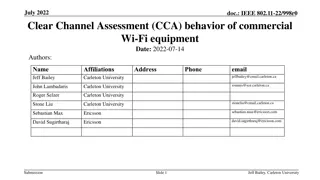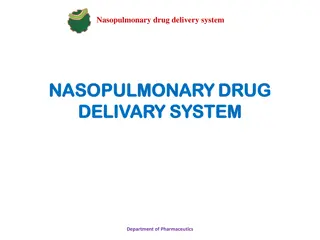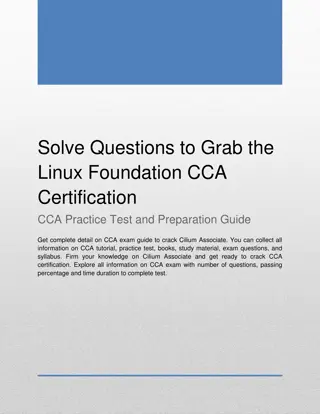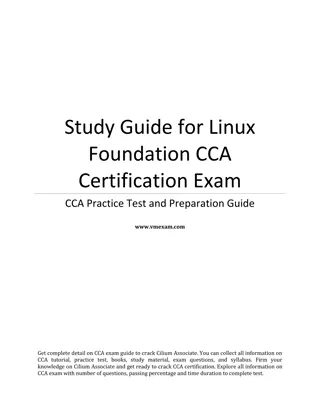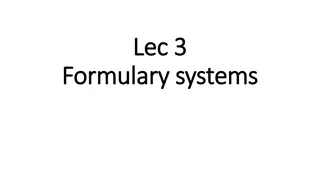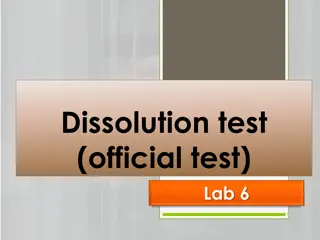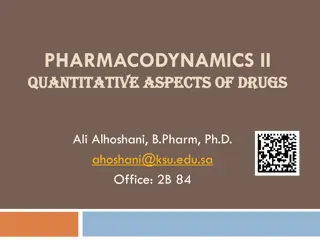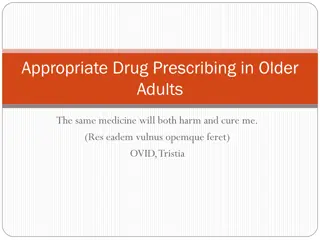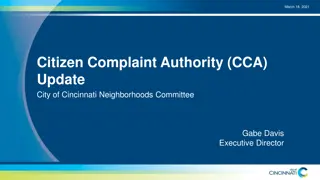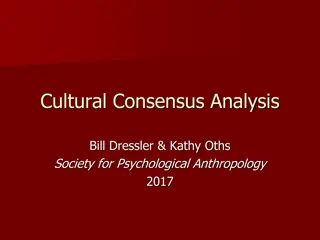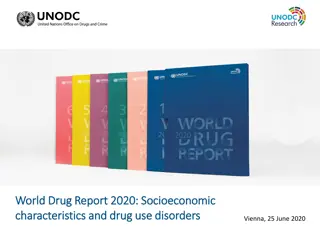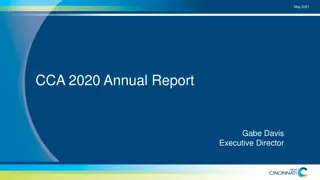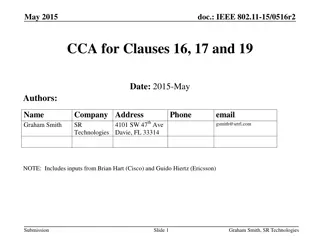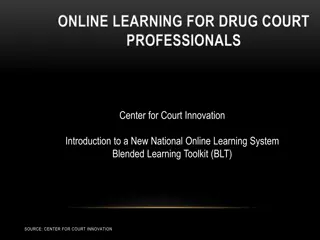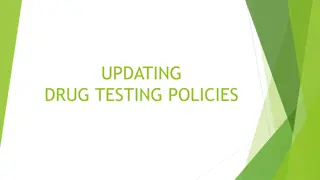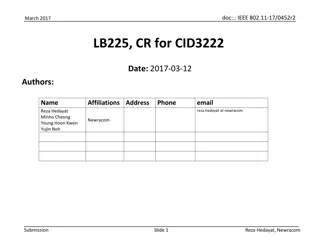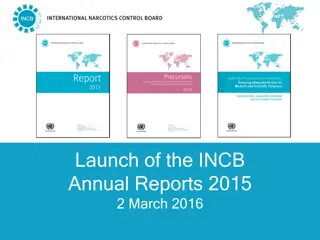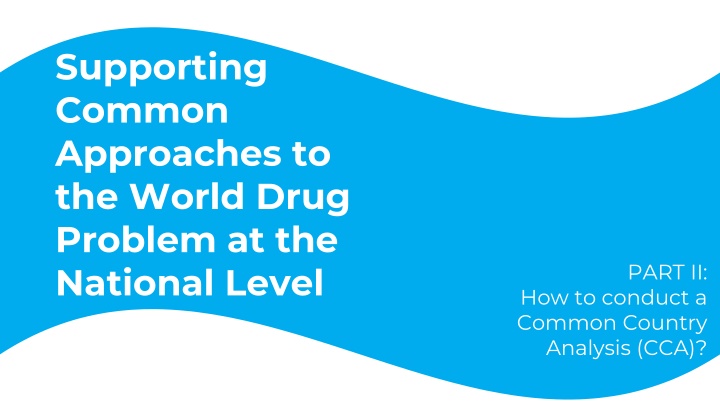
Conducting a Common Country Analysis (CCA) for Effective Drug Policy
This document outlines how to conduct a Common Country Analysis (CCA) to guide UN Country Teams in supporting Member States in implementing the Common Position on drugs. It focuses on assessing legal, policy, and institutional responses, access to controlled medicines, and considerations post-COVID-19. The CCA aims to develop balanced, comprehensive, evidence-based, and sustainable approaches to address the world drug problem while upholding human rights and promoting development.
Download Presentation

Please find below an Image/Link to download the presentation.
The content on the website is provided AS IS for your information and personal use only. It may not be sold, licensed, or shared on other websites without obtaining consent from the author. If you encounter any issues during the download, it is possible that the publisher has removed the file from their server.
You are allowed to download the files provided on this website for personal or commercial use, subject to the condition that they are used lawfully. All files are the property of their respective owners.
The content on the website is provided AS IS for your information and personal use only. It may not be sold, licensed, or shared on other websites without obtaining consent from the author.
E N D
Presentation Transcript
Supporting Common Approaches to the World Drug Problem at the National Level PART II: How to conduct a Common Country Analysis (CCA)?
PART II of this document was created to guide UN Country Teams in conducting a CCA that supports national efforts to implement the Common Position on drugs. Supporting Member States in developing and implementing truly balanced, comprehensive, integrated, evidence-based, human rights-based, development-oriented and sustainable responses to the world drug problem, within the framework of the 2030 Agenda for Sustainable Development - UN Common Position, 2018
What is a CCA? The CCA allows UN Country Teams to support Member States in considering legal, policy, institutional, and programmatic responses to address the drug problem within a truly balanced, comprehensive, integrated, evidence-based, human rights-based, development-oriented and sustainable approach
How to conduct a CCA? I. Assessment of the national legal, policy and institutional provisions (I) and (II) III. Assessment of access to controlled medicines IV. Issues to consider during/after COVID-19 II. Assessment of the size and nature of the drug problem
1 Review if legal frameworks such as criminal and administrative laws and policies governing drug-related offences such as possession, sale and use, including regarding judicial cooperation, mutual legal assistance, and extradition, meet the following criteria: I. Assessment of the national legal, policy, institutional provisions I. Assessment of the national legal, policy and institutional provisions (I) Respect, protect and fulfil the dignity and human rights of people affected by these laws and policies, including those most marginalized, such as people who use drugs, small farmers who cultivate drugs or who live in areas where drugs are cultivated; Consider alternatives to conviction and punishment in appropriate cases, including the decriminalization of drug use and possession for personal use; Incorporate the principle of proportionality in sentencing for drug related offences; Not impose the capital punishment for drug-related offences. Drug offences do not meet the internationally recognized threshold of most serious crimes ; Policing practices, such as surveillance and excessive use of force, do not target vulnerable and marginalized populations leading to the stigmatization of such groups that may increase the risks of physical and mental health issues for people who use drugs.
2 Analyse whether laws and policies ensure access and availability, on a non-discriminatory basis, in the community and in prison and other closed settings, to: controlled medicines for legitimate medical and scientific purposes, including the relief of pain, palliative care and treatment of drug dependence; scientific, evidence-based treatment services for people with drug dependence use disorders in the community and prison settings; Naloxone and other interventions to reverse or prevent and manage overdose; services for prevention of adverse health consequences of drug use. I. Assessment of the national legal, policy, institutional provisions Assess if legal means for international cooperation (such as judicial cooperation, mutual legal assistance, confiscation, extradition, transfer of proceedings) are included in legislations and policies that address illicit drug trade consistent with obligations under international drug and human rights treaties 3 Assess if institutional policies promote the active involvement and participation of civil society and local communities, including people who use drug as well as women and youth 4
1 Assess if sub-national and national level information (disaggregated by type of drug, sex , ethnicity, race and age) is available on: Prevalence of drug use in the general population and among youth (general population/school surveys); Estimates of people who use drugs and are particularly vulnerable to health harms (such as those who inject drugs); Estimates of prevalence of drug use disorders; Drug related morbidity (non-fatal overdose, HIV, Hepatitis C and TB among people who use/inject drugs); Drug related mortality, including overdose deaths; Number of people provided treatment for drug use disorders; Service capacity for prevention and management of drug use disorders in health and social care systems. 2 Review qualitative information on possible new trends in terms of drugs where use is expanding/contracting, drugs that are particularly harmful, and sub-population groups that may emerge as particularly vulnerable to drug use (such as youth, people living in marginalized communities); 3 Review sub-national and national level information available on the above indicators by relevant sub-population groups such as migrants, people in prison settings, sex workers, men who have sex with men, etc. II. Assessment of the size and nature of the drug problem Drug Use and Health Consequences
1 Assess if sub-national and national level information (disaggregated by type of drug, sex , ethnicity, race and age) is available on: Prevalence of drug use in the general population and among youth (general population/school surveys); Estimates of people who use drugs and are particularly vulnerable to health harms (such as those who inject drugs); Estimates of prevalence of drug use disorders; Drug related morbidity (non-fatal overdose, HIV, Hepatitis C and TB among people who use/inject drugs); Drug related mortality, including overdose deaths; Number of people provided treatment for drug use disorders; Service capacity for prevention and management of drug use disorders in health and social care systems. 2 Review qualitative information on possible new trends in terms of drugs where use is expanding/contracting, drugs that are particularly harmful, and sub-population groups that may emerge as particularly vulnerable to drug use (such as youth, people living in marginalized communities); 3 Review sub-national and national level information available on the above indicators by relevant sub-population groups such as migrants, people in prison settings, sex workers, men who have sex with men, etc. II. Assessment of the size and nature of the drug problem Drug Use and Health Consequences
1 Assess if there are programmes and initiatives aimed at reducing stigma and eliminate discrimination that represent barriers for persons who use drugs to access treatment services; II. Assessment of the drug policy responses 2 Assess coverage and quality of prevention and treatment services in the general population and prisons and other closed settings, evaluating if programmes for prevention of substance use are: based on scientific evidence - International Standards on Drug Use Prevention and related CND resolutions ensuring the healthy and safe development of children and youth so that they can realize their talents and potential and become contributing members of their community and society; effective, in the sense that they contribute significantly to the positive engagement of children, youth and adults with their families and in their schools, workplaces and communities. 3 Assess the magnitude of investment in drug prevention and treatment measures as compared to national needs: compare investments made in this field in other countries in the region and beyond; evaluate how investments in this area compares with investments in other areas of public health. Health and Drug Use
4 Assess if prevention and treatment services: are compliant with fundamental rights (bodily integrity, due process, and freedom from arbitrary detention), assessing in particular, if there are compulsory drug rehabilitation /detention centers; are provided in accordance with the right to health, that is: provided on a voluntary basis and available, accessible, acceptable, delivered in a scientifically sound and medically appropriate manner and of good quality (with a strong evidence base and independent oversight) WHO/UNODC International Standards for the Treatment of Drug Use Disorders; are part of the Universal Health Coverage (UHC) assessing if drug use disorders and other drug-related health conditions are included in the overall UHC framework in national health systems; address the diverse needs of women and pregnant women; children and adolescents; elderly people; indigenous populations; migrants; sex workers; people with different sexual orientation and gender identity etc.; have sufficient capacity of treatment and care services to ensue non- discriminative and affordable access to prevention, treatment and care for drug use disorders, also, when appropriate, as alternatives to conviction or punishment; safeguard the confidentiality of all identifying information regarding an individual s involvement in drug-related health care to ensure that it is used solely for the purpose of advancing the health of that person. II. Assessment of the drug policy responses Health and Drug Use
3 Assess if prevention and treatment services: are compliant with fundamental rights (bodily integrity, due process, and freedom from arbitrary detention), assessing in particular, if there are compulsory drug rehabilitation /detention centers; are provided in accordance with the right to health, that is: provided on a voluntary basis and available, accessible, acceptable, delivered in a scientifically sound and medically appropriate manner and of good quality (with a strong evidence base and independent oversight) WHO/UNODC International Standards for the Treatment of Drug Use Disorders; are part of the Universal Health Coverage (UHC) assessing if drug use disorders and other drug-related health conditions are included in the overall UHC framework in national health systems; address the diverse needs of women and pregnant women; children and adolescents; elderly people; indigenous populations; migrants; sex workers; people with different sexual orientation and gender identity etc.; have sufficient capacity of treatment and care services to ensue non- discriminative and affordable access to prevention, treatment and care for drug use disorders, also, when appropriate, as alternatives to conviction or punishment; safeguard the confidentiality of all identifying information regarding an individual s involvement in drug-related health care to ensure that it is used solely for the purpose of advancing the health of that person. II. Assessment of the drug policy responses Health and Drug Use
1 Assess availability of services and programmes aimed at minimizing the adverse public health consequences of drug use, that reduce new HIV and viral hepatitis infections, provide treatment and care for drug users with HIV, TB and viral hepatitis, improve other health outcomes and social reintegration of people who use drugs, and deliver broader social benefits, including by reducing pressure on health care and criminal justice systems. These may include implementing comprehensive HIV and HCV Programmes with People who Inject Drugs (WHO, UNODC, UNAIDS Technical Guide for Countries to Set Targets for Universal Access to HIV Prevention, Treatment and Care for Injecting Drug Users ): needle and syringe programmes; opioid substitution therapy; HIV testing services; antiretroviral therapy; prevention and treatment of sexually transmitted infections; condom programmes for people who inject drugs and their sexual partners; targeted information, education and communication; prevention, vaccination, diagnosis and treatment of viral hepatitis B and C; prevention, diagnosis and treatment of tuberculosis (Policy Guidelines for Collaborative TB and HIV Services for Injecting and Other Drug Users: An Integrated Approach); community distribution of naloxone. 2 Assess if services are adequately funded compared to national needs: compare investments made in this field in other countries in the region and beyond and evaluate how investments in this area compares with investments in other areas of public health. II. Assessment of the drug policy responses HIV and HCV
1 Review sub-national and national level information (disaggregated by type of drug) available on: the number and quantities of drugs and precursors seized (inbound/outbound); prices/purity of drugs; production and manufacture of drugs; illicit cultivation of drugs; emergence of new psychoactive substances (not under national and international control) (UNODC Early Warning Advisory); number of people arrested for drug law offences by type of offences (use/possession and trafficking), prosecuted and convicted (by sex and age); number of people in prison for drug law offences (by sex and age and type of offences use/possession and trafficking); type of detainees: sentenced detainees and unsentenced (pre-trial) detainees; Number of people sentenced to death and executed (where death penalty is imposed for drug related offences); data/information on violence related to drug trafficking and transnational drug trafficking organizations; trend of specific drug markets, qualitative information on markets expanding/contracting, possible new drug supply threats. II. Assessment of the size and nature of the drug problem Illicit drug cultivation, production, trafficking, and drug-related offences If adequate information is not available, to highlight the lack of evidence to inform policy.
1 Review sub-national and national level information (disaggregated by type of drug) available on: the number and quantities of drugs and precursors seized (inbound/outbound); prices/purity of drugs; production and manufacture of drugs; illicit cultivation of drugs; emergence of new psychoactive substances (not under national and international control) (UNODC Early Warning Advisory); number of people arrested for drug law offences by type of offences (use/possession and trafficking), prosecuted and convicted (by sex and age); number of people in prison for drug law offences (by sex and age and type of offences use/possession and trafficking); type of detainees: sentenced detainees and unsentenced (pre-trial) detainees; Number of people sentenced to death and executed (where death penalty is imposed for drug related offences); data/information on violence related to drug trafficking and transnational drug trafficking organizations; trend of specific drug markets, qualitative information on markets expanding/contracting, possible new drug supply threats. II. Assessment of the size and nature of the drug problem Illicit drug cultivation, production, trafficking, and drug-related offences If adequate information is not available, to highlight the lack of evidence to inform policy.
II. Assessment of the drug policy responses 1 Review whether there are adequate services and programmes in place that aim at reducing the overall supply of illicit drugs such as: promoting sustainable livelihoods through adequately-sequenced, well-funded and long-term development-oriented drug policies in rural and urban areas affected by illicit drug activities, including cultivation, production and trafficking, bearing in mind environmental protection the protection of human rights, including livelihood and health and sustainability; support the identification of prevalent, persistent and harmful psychoactive drugs, including new psychoactive substances, and their associated health risks, using global and regional agencies early warning and alert systems; guidance and legal/technical assistance to strengthen cross-border law enforcement and judicial cooperation. Supply Reduction
1 Assess availability of services and programmes aimed at minimizing the adverse public health consequences of drug use, that reduce new HIV and viral hepatitis infections, provide treatment and care for drug users with HIV, TB and viral hepatitis, improve other health outcomes and social reintegration of people who use drugs, and deliver broader social benefits, including by reducing pressure on health care and criminal justice systems. These may include implementing comprehensive HIV and HCV Programmes with People who Inject Drugs (WHO, UNODC, UNAIDS Technical Guide for Countries to Set Targets for Universal Access to HIV Prevention, Treatment and Care for Injecting Drug Users ): needle and syringe programmes; opioid substitution therapy; HIV testing services; antiretroviral therapy; prevention and treatment of sexually transmitted infections; condom programmes for people who inject drugs and their sexual partners; targeted information, education and communication; prevention, vaccination, diagnosis and treatment of viral hepatitis B and C; prevention, diagnosis and treatment of tuberculosis (Policy Guidelines for Collaborative TB and HIV Services for Injecting and Other Drug Users: An Integrated Approach); community distribution of naloxone. 2 Assess if services are adequately funded compared to national needs: compare investments made in this field in other countries in the region and beyond and evaluate how investments in this area compares with investments in other areas of public health. II. Assessment of the drug policy responses Criminal Justice
III. Assessment of access to controlled medicines 1 Review if there are internationally controlled narcotic drugs and psychotropic substances available and accessible for medical and scientific purposes (Technical Guidance: Increasing Access and Availability of Controlled Medicines; and International Narcotics Control Board) 2 Assess if there are barriers to the availability and accessibility of controlled substances for medical and scientific purposes, such as: Lack of training/awareness of professionals; Cultural attitudes, fear of drug dependence; Fear of diversion; Limitation in trade control measures; Limited financial resources; Fear of prosecution/sanctions; Onerous regulations; Limited health-care providers who are allowed to prescribe controlled medications especially for pain management and palliative care; Limited ability of health-care providers to identify and mitigate risks of drug use disorders associated with prescription of dependence-producing controlled medicines; Problems in sourcing.
1 Consider if the UN Framework for immediate Socio-Economic Response to COVID-19 ensure that: IV. Issues to consider during and after COVID-19 people who use drugs, including those in drug treatment and those who are in prison or other closed settings are included in efforts to address COVID-19 and in the ensuing recovery; safeguards are in place to ensure that drug related financial resources do not infiltrate the legal economy; recovery programmes include rural and urban households and communities affected by illicit drug activities, including small farmer households dependent on illicit drug crop economies, as well as other populations whose poverty or marginalization puts them at risk of engaging in illicit drug cultivation/production/trafficking to overcome the crisis.


